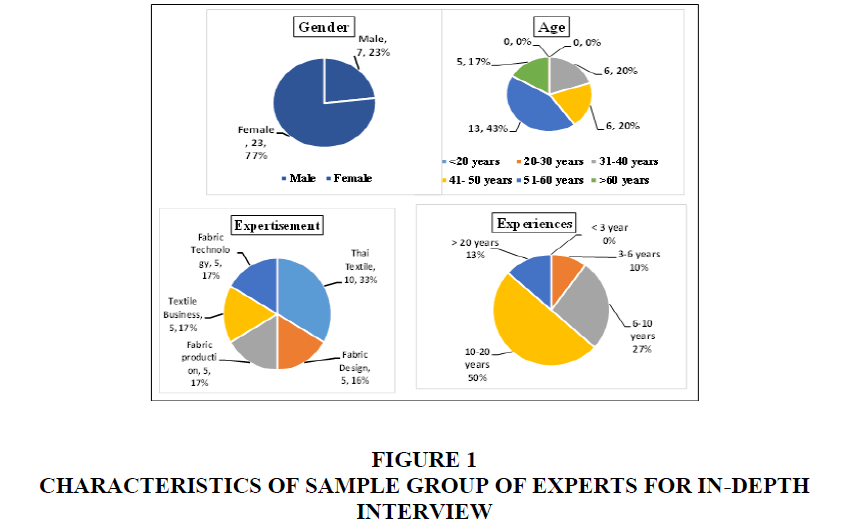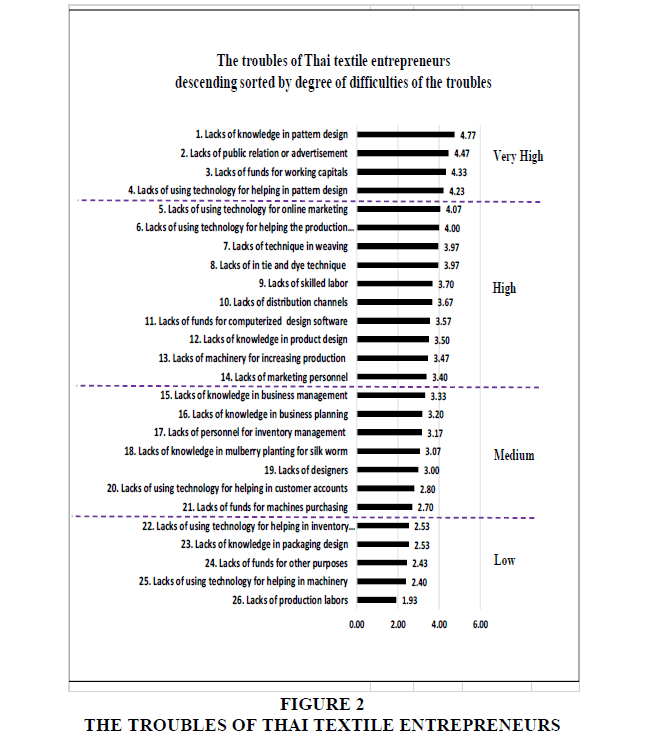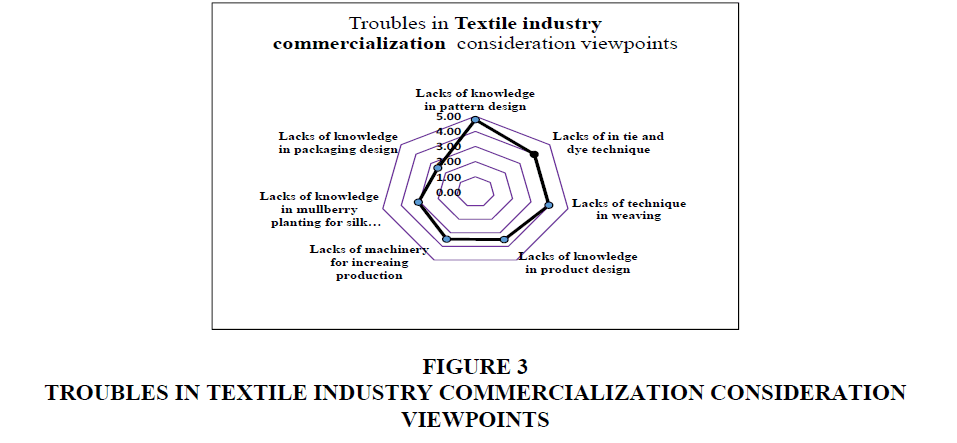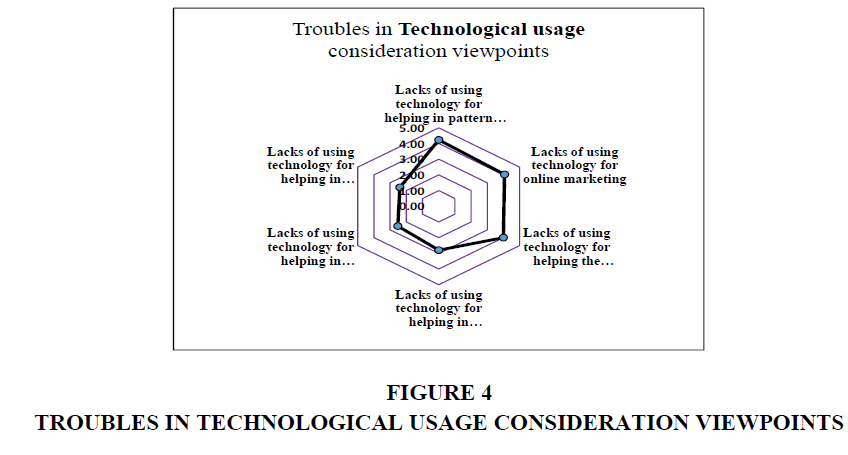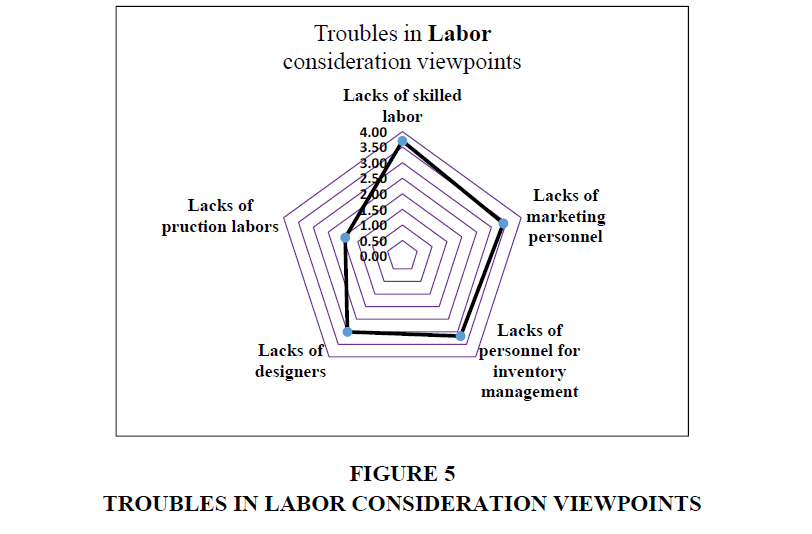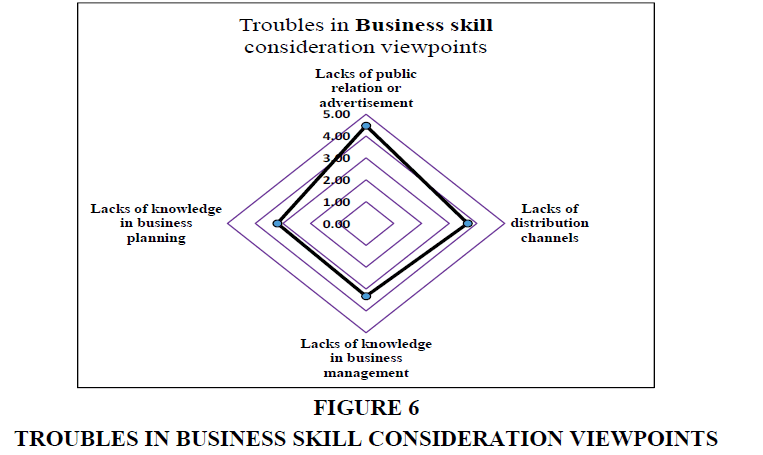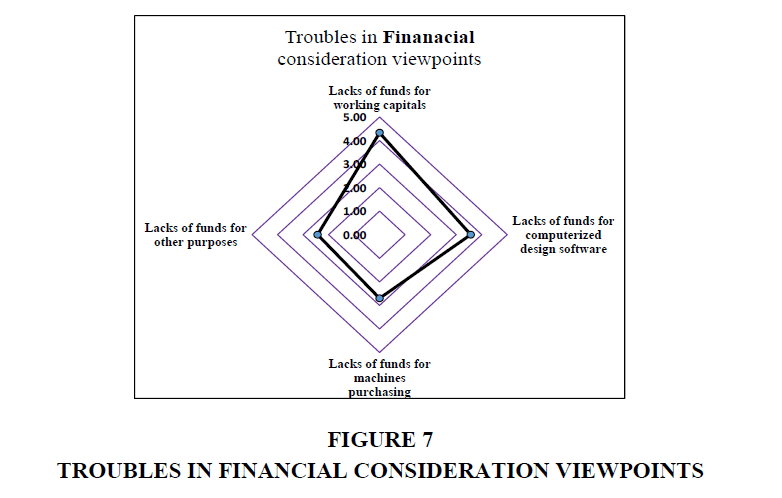Research Article: 2018 Vol: 24 Issue: 3
Adapt or Die, Thai Traditional Textiles Entrepreneurs
Yupha Taweewattanakitborvon, Chulalongkorn University
Pongpun Anuntavoranich, Chulalongkorn University
Achara Chandrachai, Chulalongkorn University
Phannaphatr Savetpanuvong, Chulalongkorn University
Keywords
Thai Traditional Textiles, Entrepreneur, Troubles, Incubation.
Introduction
Culture industry was used as a tool in economic development in several countries. There was linkages from cultural capitals into economic system to be cultural assets, local intellectuals and acknowledgements (Sardana, 2018) By the direction of policy of government of Thailand that aims to change to creative economy that was the concept driving economy by using knowledge, creativity and intellectual properties linked to cultural.
Thailand, a Southeast Asian country, had a plenty of cultural heritages especially for local old styles fabrics from every regions of the country, for example, PAJOK silk (a skirt live dress pattern woven with silk) from Central region, IKAT silk (Thai wrap-around skirt) from Central region,, SARONG style skirt, PA-YOK (Thai silk with prominent flower pattern) from Southern region, Flowing pattern Fabric from the Northern region, etc. By the direction of policy of government of Thailand that aims to change to creative economy that was the concept driving economy by using knowledge, creativity and intellectual properties linked to cultural.
Thai traditional fabric is one of the most promising cultural capitals that play a vital role in helping the country’s economic growth. As known that exporting was one of a vital part of economic system of Thailand. Statistics records from Bank of Thailand showed that in year 2016-2017, commodities from cultural capitals in textile segment was ranked 10th of all commodities, with 7,225,722.80, 7,550,704.07 and 8,006,265.18 Million Baht in year 2015-2017. Although cultural commodities, especially in Thai traditional textiles, continuously generated revenues to Thailand. There was still no significant in growth rate in each year. Exporting values of Thai traditional textiles in year 2015, 2016, 2017 at 15,244.88, 14,240.80, and 14,104.62 Million Baht, respectively that was not significantly different in each year (Ministry of Commerce, Thailand, 2017). It implied that even if Thailand has several of cultural capitals, hence it becomes the reason why they have to urgently adapt themselves or die.
Literature Review
Business Potential
Potential on a personal level that has the ability to act in doing anything until the desired achievement is met. Knowledge and positive thinking were not the only factors essential in achieving a successful life. A successful person should have the potential in performing with a strong devotion to change ones’ owns life (Alstete, 2014). Business potential could be classified into 3 categories such as work experience, knowledge of the business and business ability which could be described as follows:
Work experience
Describes how entrepreneurs should reflect on their previous mistakes and prevent, said mistakes, from occurring again in the future. Through proper application to their current works, they are able to develop better work procedures that produce better results. In the case of any obstacles that may threaten the success of their work, they create new solutions to solve the problems with a flexible plan until their work is completed. Finally, entrepreneurs should listen to expert’s advice and opinions (Franco and Filson 2006).
Knowledge of the business
It is the most important foundation for launching one’s own business (Turker 2009). There are 2 components of knowledge that are important for entrepreneurs, first, general knowledge of business, such as knowledge of the production processes, technology implementation, business plan and management; second, specific knowledge of relevant businesses. In the case of the cultural entrepreneur of Thai traditional textiles, the important things that one has to know are: 1) knowledge of textile production process, starting from mulberry cultivation, silk worm farming, tie and dye technique, pattern design, product design and machine manufacturing. Entrepreneurs need to know about how to design, process, dye, weave, etc. 2) Knowledge of doing business, starting from the business plan, accounting, product development, managerial skills, including human resource management, financial management and inventory management (Nukul, 2004).
Business ability
The characteristics of an entrepreneur could be used as a form of self-assessment to estimate the likelihood of becoming an entrepreneur, such as innovative ability, tolerance ambiguity, desire to achieve, realistic planning ability, goal-oriented leadership, objectivity, personal responsibility and adaptability. The successful adaptation and creation of sustainable entrepreneurial ventures significantly influences the ability to create more environmentally and socially integrated economic systems. Sustainable business models are a critical component towards this goal (Neumeyer et al., 2018).
Business Commitment
It was found that entrepreneurs had a high motivation for achievement rather than money. The need for achievement was motivation itself, which gave the person the strong desire to attain a standard of excellence, to have self-esteem and to compete one’s own self. However, the entrepreneurs could be built through training and motivation such as by providing systematic trainings, including available environments Moreover, self-employed entrepreneurs committed themselves to any entrepreneurship training program and commitment related to their perceptions of learning (Nieminen, 2016). The achievement motivation was one of the characteristics in entrepreneurs that could be used as a reference framework for careers and entrepreneurships (Luca and Robu, 2016). Motivation was the main condition for increasing the behavior of an individual who wanted to be an entrepreneur and achieve the desired goals.
Business Opportunity Vision
An entrepreneur was a person who saw opportunities and could leverage limited resources to create or improve new products or services for selling (Jones and George, 2003). The entrepreneurship was the operation for developing products or innovations and looking for new markets. The key elements of entrepreneurship were creativity and business expansion, business innovations, perception and self-control, business perception and recognition, business vision, risk and uncertainty acceptance, independent creativity, vision for new resources, old talent mergence to the opportunity and new ideas for business sustainability. A well-defined business idea is essential for nascent business sustainability in the future. The business idea must fit firm knowledge and resources to a profitable business opportunity (Casali and Perano, 2018).
The Potential of Cultural Entrepreneurs
Culture industry was used as a tool for economic development in many countries by bringing the culture which reflected the local life and livelihood to create commercial products. It combined cultural capital, economy, cultural asset, local wisdom and body of knowledge. Therefore, culture was built to create value for goods and services in terms of cultural goods such as textiles and garments, handicrafts and local food, etc., which were able to generate income directly and indirectly. A cultural entrepreneur is a person who makes an impact on cultures and has a vision for making income from cultural activities. Cultural industries and of the creative economy, are driving factors of economic growth and local development (Boccella and Salerno, 2016). Cultural entrepreneurs were important in several aspects. First, cultural industries created jobs and economic growth. Second, they generated local economic growth which created sustainable jobs and did not fall into according to the global economy due to the emphasis on people rather than being capital intensive. Third, they are new models of work and have the freedom to work and are able to develop self-employment. Fourth, there creative production model and independent work helped to develop cooperation with other firms and form creativity networks. Fifth, they play an important role in the expansion and growth of the city. Sixth, they help built social linkages by promoting a strong sense of local ownerships. The cultural goods and services consisted of the readiness of entrepreneurs (entrepreneurial characteristics, knowledge and entrepreneurial skills) and the readiness of cultural goods and services (the characteristics of goods and services, the inheritance of the concepts of wisdom, the process of creating goods and cultural services to the next generation. Moreover, cultural entrepreneurs refer to artists who pursue not only cultural works but also entrepreneurial practices as business owners (Kim, 2016).
Research Questions
Since Thailand had a varieties of traditional textiles that seemed to be valuable to create revenues to the country. There was still no significant in growth rate of revenues from such segment in each year. Exporting values of Thai traditional textiles in year 2015, 2016, 2017 respectively that was not significantly different in each year as mentioned before. It implied that even if Thailand has good cultural capitals, it still faced with some troubles to utilize them. To solve those troubles, it should be know the causal reasons behind that. It became the research questions of this article as follows: What are the critical troubles for the development of Thai traditional textile entrepreneurs? And how to solve the mentioned troubles?
Research Methodology
The research applied qualitative research by using in-depth interviews technique to find out the information about what the critical troubles for the development of Thai traditional textile entrepreneurs are and how to solve the mentioned troubles. Method of interview was semi-structured interview by interview scripts about what are the troubles or obstacles for Thai traditional textile entrepreneurs in doing business. The questions were open-ended for freely answer and opinions express. Interview scripts were screened and checked by experts. The interview process is performed during January 2016-2017. Finally, data was brought to do content analysis to find out the answer of research question.
The population of the study was 3,407 Thai textile entrepreneurs nationwide who formally registered with the Ministry of Culture in 2015. By selecting 30 experts in cultural products industry- consisted of equally 15 experts in Thai textile fabrication and 15 experts in performing textile business. Experts in Thai textiles were purposively selected from the heads of Thai textile clubs in local provinces in Thailand from all regions of Thailand e.g. provinces in North-Eastern region, Northern region and Southern region, namely-Ubon Ratchathani, Chaing Mai and Songkhla respectively. It was certain that all of those provinces were famous for local Thai traditional textile styles. While experts in doing fabric business were owners of famous Thai textile shops in Thailand.
Results Of Study
The sample groups of experts for in-depth interview have characteristics as descripted in Table 1 and depicted in Figure 1.
| Table 1 CHARACTERISTICS OF SAMPLE GROUP OF EXPERTS FOR IN-DEPTH INTERVIEW |
|||
| Type | Characteristic | Quantities (Person) | Percentage |
| Gender | Male | 7 | 23% |
| Female | 23 | 77% | |
| Age | <20 Years | 0 | 0% |
| 20-30 Years | 0 | 0% | |
| 31-40 Years | 6 | 20% | |
| 41-50 Years | 6 | 20% | |
| 51-60 Years | 13 | 43% | |
| >60 Years | 5 | 17% | |
| Expertise | Thai Textile | 10 | 33% |
| Fabric Design | 5 | 17% | |
| Fabric Production | 5 | 17% | |
| Textile Business | 5 | 17% | |
| Fabric Technology | 5 | 17% | |
| Experiences in Thai textiles | <3 Year | 0 | 0% |
| 3-6 Year | 3 | 10% | |
| 7-10 Year | 8 | 27% | |
| 11-20 Year | 15 | 50% | |
| >20 Year | 4 | 13% | |
The Troubles of Thai textile Entrepreneurs
The troubles classifying by degree of difficulties of the troubles
By using in-depth interviews with the sample group of experts. By given the interviewees to score the level of difficulties by 1-5 points scales, ranges by the least difficult is 1 point to the most difficult is 5 points The results revealed that there are 26 troubles faced by the Thai textile entrepreneurs as descending listed by average scores shown in Figure 2. The troubles of Thai textile entrepreneurs according to the degree of difficulties of the trouble to the less one. Higher scores imply that it is more difficult for that trouble.
“Very high level” of troubles: It found that there are four troubles faced by Thai textile entrepreneurs at “Very high level” of troubles. It shows that lacks of knowledge in pattern design, lacks of public relation or advertisement, lacks of funds for working capitals and lacks of using technology for helping in pattern design are the most high level of troubles with score 4.77, 4.47, 4.33 and 4.23 from 5 scale score, respectively, as shown in Figure 3.
“High level” of troubles: It found that there are ten troubles faced by Thai textile entrepreneurs at “High level” of troubles. It shows that lacks of using technology for online marketing, lacks of using technology for helping the production processes, lacks of technique in weaving, lacks of in tie and dye technique, lacks of skilled labor, lacks of distribution channels, lacks of funds for computerized design software, lacks of knowledge in product design, lacks of machinery for increasing production and lacks of marketing personnel are the next most high level of troubles, respectively, as shown in Figure 4.
“Medium level” of troubles: It found that there are seven troubles faced by Thai textile entrepreneurs at “Medium level” of troubles. It shows that lacks of knowledge in business management, lacks of knowledge in business planning, lacks of personnel for inventory management, lacks of knowledge in mulberry planting for silk worm, lacks of designers, lacks of using technology for helping in customer accounts, lacks of funds for machines purchasing, respectively, as shown in Figure 5.
“Low level” of troubles: It found that there are five troubles faced by Thai textile entrepreneurs at “Low level” of troubles. It shows that lacks of using technology for helping in inventory management, lacks of knowledge in packaging design, lacks of funds for other purposes, lacks of using technology for helping in machinery and Lacks of production labors, respectively, as shown in Figure 6.
The Troubles Classifying By the Viewpoint of the Troubles
The results can be analyzed according to the four consideration viewpoints, namely, firstly-commercialization viewpoints, secondly-technological usage viewpoints, thirdly, business doing viewpoints and fourthly, funds or monetary viewpoints.
In textile industry commercialization viewpoints
It found that the top three troubles are that lacks of knowledge in pattern design is the most in troubles, following by lacks of tie and dye technique and lacks of technique in weaving, respectively. As depicted in Figure 3 and shown in Table 2.
| Table 2 TROUBLES IN TEXTILE INDUSTRY COMMERCIALIZATION CONSIDERATION VIEWPOINTS |
||||
| No. | Troubles | Average Scores | Standard Deviation | Meanings of Scores |
| 1 | Textile Industry Commercialization Consideration Viewpoints | |||
| 1.1 | Lacks of knowledge in pattern design | 4.77 | 0.57 | Very High |
| 1.2 | Lacks of in tie and dye technique | 3.97 | 0.62 | High |
| 1.3 | Lacks of technique in weaving | 3.97 | 1.38 | High |
| 1.4 | Lacks of knowledge in product design | 3.50 | 1.08 | High |
| 1.5 | Lacks of machinery for increaing production | 3.47 | 0.86 | High |
| 1.6 | Lacks of knowledge in mullberry planting for silk | 3.07 | 0.25 | Medium |
| 1.7 | Lacks of knowledge in packaging design | 2.53 | 1.01 | Low |
In technological usage viewpoints
It found that the top three troubles are that lacks of using technology for helping in pattern design, following by lacks of using technology for online marketing and lacks of using technology for helping the production processes, respectively. As depicted in Figure 4 and shown in Table 3.
| Table 3 TROUBLES IN TECHNOLOGICAL USAGE CONSIDERATION VIEWPOINTS |
||||
| No. | Troubles | Average Scores | Standard Deviation | Meanings of Scores |
| 2 | Technological Usage Consideration Viewpoints | |||
| 2.1 | Lacks of using technology for helping in pattern design | 4.23 | 0.86 | Very High |
| 2.2 | Lacks of using technology for online marketing | 4.07 | 0.83 | High |
| 2.3 | Lacks of using technology for helping the production processes | 4.00 | 0.79 | High |
| 2.4 | Lacks of using technology for helping in customer accounts | 2.80 | 0.89 | Medium |
| 2.5 | Lacks of using technology for helping in inventory management | 2.53 | 1.13 | Low |
| 2.6 | Lacks of using technology for helping in machinery | 2.40 | 1.25 | Low |
In labor consideration viewpoints
It found that the top three troubles are that lacks of skilled labor, following by lacks of marketing personnel and lacks of personnel for inventory management, respectively. As depicted in Figure 5 and shown in Table 4.
| Table 4 Troubles in labor consideration viewpoints |
||||
| No. | Troubles | Average Scores | Standard Deviation | Meanings of Scores |
| 3 | Labor Consideration Viewpoints | |||
| 3.1 | Lacks of skilled labor | 3.73 | 0.99 | High |
| 3.2 | Lacks of marketing personnel | 3.40 | 0.93 | High |
| 3.3 | Lacks of personnel for inventory management | 3.17 | 0.75 | Medium |
| 3.4 | Lacks of designers | 3.00 | 1.15 | Medium |
| 3.5 | Lacks of production labor | 1.93 | 0.83 | Low |
In business skills consideration viewpoints
It found that the top three troubles are that lacks of public relation or advertisement, following by lacks of distribution channel sand, lacks of knowledge in business management, respectively. As depicted in Figure 6 and shown in Table 5.
| Table 5 TROUBLES IN BUSINESS SKILL CONSIDERATION VIEWPOINTS |
||||
| No. | Troubles | Average Scores | Standard Deviation | Meanings of Scores |
| 4 | Business Skill Consideration Viewpoints | |||
| 4.1 | Lacks of public relation or advertisement | 4.47 | 0.68 | Very High |
| 4.2 | Lacks of distribution channels | 3.67 | 0.84 | High |
| 4.3 | Lacks of knowledge in business management | 3.33 | 0.76 | Medium |
| 4.4 | Lacks of knowledge in business management | 3.20 | 1.00 | Medium |
In financial consideration viewpoints
It found that the top three troubles are that lacks of funds for working capitals, following by lacks of funds for computerized design software and lacks of funds for machines purchasing, respectively. As depicted in Figure 7 and shown in Table 6.
| Table 6 TROUBLES IN FINANCIAL CONSIDERATION VIEWPOINTS |
||||
| No. | Troubles | Average Scores | Standard Deviation | Meanings of Scores |
| 5 | Financial Consideration Viewpoints | |||
| 5.1 | Lacks of funds for working capitals | 4.33 | 0.76 | Very High |
| 5.2 | Lacks of funds for computerized design software | 3.57 | 0.63 | High |
| 5.3 | Lacks of funds for machines purchasing | 2.70 | 0.47 | Medium |
| 5.4 | Lacks of funds for other purposes | 2.43 | 0.90 | Low |
The Problem Solving For the Troubles of Thai Textile Entrepreneurs
By using in-depth interviews with the sample group of experts. The author interviewed the experts in sample group to raise the problem solutions. Then the experts proposed the problem solving method for the troubles in several aspects as follows.
| Table 7 EXAMPLES OF PROPOSED TROUBLES AND SOLUTIONS FROM THE EXPERTS IN THAI TRADITIONAL TEXTILE |
|||
| No. | Experts | Quotes from interview about the troubles | Proposed solutions |
| 1 | Ms. Sumolmal Taeja- An expert in Thai traditional textile, group leader of textile fabrication of Kood-Kwang-Soi village, Nong-Bua-Lam-Poo Province in the North Eastern region of Thailand, owner of a clothing shop named “Khwun-Ta”. | “Thai textile cultural entrepreneur is not only selling textile. They should comprehensively know their textile products, categories of textile, production processes, makers and markets etc. They should have passion in what they do”. | Thai textile entrepreneurs should comprehensively know their textile products. |
| 2 | Dr. Udom Sompon-An expert in Thai traditional textile, group leader of agriculture cooperative Thai-Vietnamese in Rajburi province in the West of Thailand. | “One who would be a good entrepreneur should have knowledge and understanding in managing product development and in seeking markets. For example, Teen-jok Thai-Vietnamese textile that has the prominence in nipping process that has delegate and unique local pattern and color.” “The troubles faced in traditional textile business is to seek the distribution channels. In case that there are less demands, the villagers will produce those textiles only in leisure time.” |
Thai textile entrepreneurs should be good at managing product development and in seeking markets. |
| 3 | Ms. Thongsiri Pukkaew-An expert in Thai traditional textile, group leader of female villager community enterprise in Sakolnakorn, who owned the “Thongsiri Pale-blue textile”. | “The reasons why people did not wear Thai traditional textile is that the unfashionable patterns. Almost of Entrepreneurs trapped in the old styles”. | Thai textile entrepreneurs should know to how to design product properly. |
| 4 | Mr. Paothon Thongjuer- An famous Thai traditional textile expert who are well-known in Thailand and in the foreign country, an owner of a clothing shop in Thailand. | “Thai government departments did not cooperate in working to each other. Villagers had to be trained in the repetitive subjects. So, the development paces have been delayed.” | Government departments should provide training for the entrepreneurs. |
| 5 | Mr. Komol Pamichpun-A Thai traditional textile expert who owns antique textile museum and a shop as learning sources in Pae, Northern Province in Thailand. | “Thai traditional textile is valuable cultural heritage and distinctive characteristics. In bringing identity of the products to on top develop to serve needs and to solve the troubles of consumers in maintenance, laundry, and pricing. Technology or innovation can be used to improve Thai traditional textile to be more interesting and be responded to consumers’ needs that leads to increase competitive advantage”. | Technology should be used to improve Thai traditional textile. |
| 6 | Mr. Nitud Kuppeng- An Thai traditional textile expert, who is a local intellectual teacher and own a shop named “Puranach”, a domestic “Lanna style” in Chiangmai, northern province in Thailand. |
“Charming of Thai traditional textile are handicrafts, hand making in piece by piece, that are different from goods from manufacturing. Delicate and beautiful pattern of piece is different. The entrepreneur should understand this point. Anyway, we are unavoidable to bring new technology and innovation to improve Thai traditional textile.” | Entrepreneur should conserve the uniqueness of local textile, while using new technology to improve it. |
| Table 7 EXAMPLES OF PROPOSED TROUBLES AND SOLUTIONS FROM THE EXPERTS IN THAI TRADITIONAL TEXTILE |
|||
| 7 | Mr. Winai Patshim- A wisdom teacher in handicraft of the education council of Thailand, owner of Mudmee silk (a kind of Thai silk woven in northeastern Thailand) in Lopburi province. |
“Thai citizen din not like to wear Thai traditional textile. Because they thought that it was too old styles”. | Government should provide campaign for promoting Thai Textile for every use. |
| 8 | Ms. Sangium Sawanglap- The head of Banna group producing of Mud fermented fabric in Sukhothai province in Center region of Thailand. | “Thai traditional textile are not widespread in general use for the reason that it has drawbacks in difficult to preserve” | Government should provide market promotion along with tourism. |
| 9 | Ms. Sureeporn Setkawit- A owner of Peacock pattern Thai silk shop in Burirum province. |
“Thai traditional textile entrepreneur mostly run small business and they faced with shortage of funds” | Government should provide funds for working capital. |
| 10 | Mr. Chalermchai Chaiwong, The head of handcraft fabric in Udonthani (the origin of Mudmee silk with indigo dye). | “Thai traditional textile entrepreneur mostly need more knowledge in production process for local fabric. Since now, there are only old villagers who can do the local pattern of Thai silk with indigo dye” | Government should promote for knowledge transferring for special process of dye making. |
| 11 | Ms. Sriwimol Kumthorn- Head of Women's Development Group for Thai textile at Ubon Rajthani province (the origin of Kapok fabric). | “Thai traditional textile entrepreneur still lacks of creativity in pattern design for textile” | Government should support for training program in pattern design. |
| 12 | Ms. Patchaporn Noi. | “Still lacks of knowledge in doing small business” | Government should support for training program in doing business. |
Conclusion
Thai traditional textiles in Thailand should be adapting themselves in solving several troubles they faces. Several experts in interviews mostly emphasized on setting incubating center that provides activities and services systematically by setting training program that suitable for entrepreneur groups, supporting them with resources needed for doing business. Using technology and innovation in incubating process to develop the potentials of entrepreneurs to be succeeded. Moreover, the experts recommended several activities in incubating center that might help the entrepreneur to survive, for example, setting of training curriculums; providing training; pre-test and post-test assessment; providing coaching and counseling; providing resources; providing monetary services; fund raising from cooperation with other organizations; and providing distribution channels.
Future Research
How to set the appropriate incubating center that provides activities and services for improving Thai traditional textile entrepreneurs to overcome the troubles they faced is the interesting issue. The mentioned issue is in during process of research in next future by cooperation between the author and The Ministry of Culture of Thailand.
One of the limitations of this research is small research sample size. The future research would be recommended to increase the research sample size- the interviewees or the experts in the field to reach more complete considerations and various aspects. Hence, the future research should expand in samples dispersed in all nationwide provinces.
References
- Alstete, J.W. (2014). Strategy choices of liotential entrelireneurs. Journal of Education for Business, 89, 77–83.
- Boccella, N., &amli; Salerno, I. (2016). Creative economy, cultural industries and local develoliment. In 2nd International Symliosium "NEW METROliOLITAN liERSliECTIVES"-Strategic lilanning, sliatial lilanning, economic lirograms and decision suliliort tools, through the imlilementation of Horizon/Eurolie2020.
- Casali, S., &amli; lierano, K., (2018). How business idea fit affects sustainability and creates oliliortunities for value co-creation in Nascent firms. Sustainability, 10(1), 1-15.
- Franco, AM., &amli; Filson, D. (2006). Sliin-outs: Knowledge diffusion through emliloyee mobility. The Rand Journal Economics, 37(4), 841-860.
- Jones, G.R., &amli; George, J.M. (2003). Contemliorary management. New York: McGraw Hill Inc.
- Kim, J.Y. (2016). Cultural entrelireneurs and urban regeneration in Itaewon, Seoul. Journal in Cities, 56, 132-140. Elsevier Ltd liublisher.
- Luca, M.R., &amli; Robu, A. (2016). liersonality traits in entrelireneur and self-emliloyed. Bulletin of the Transilvania University of Braşov. Series VII: Social Sciences, 9(58), 115-138.
- Neumeyer, X., Santos, N., &amli; Susana, C. (2018). Sustainable business models, venture tyliologies, and entrelireneurial ecosystems: A social network liersliective. Journal of Cleaner liroduction, 172(20) 4565-4579.
- Nieminen, L. (2016). Commitment to an entrelireneurshili training lirogramme for self-emliloyed entrelireneurs, and learning from liarticiliation. Education and Training, 58(7/8), 715-732.
- Nukul, S . (2004).&nbsli; A study of the transfer of traditional folk arts and weaving in southern Thailand, (lih.D. thesis Art Education). Graduate School Srinakharinwirot University, Bangkok, Thailand. lihotocoliying.
- Sardana, D. (2018). What facilitates cultural entrelireneurshili? A study of Indian cultural entrelireneurs. Journal of Creative Behavior, 52(1), 35-51.
- Turker, D. (2009). How corliorate social reslionsibility influences organizational commitment. Journal of Business Ethic, 89(2), 189-204.
- Walken, K., &amli; Christoliher, E. (2015).&nbsli; Influence of the motivation of entrelireneurs on the willingness to take risks. Journal of Interdiscililinary Research, 5(1), 38-40.
